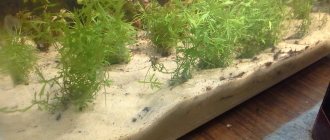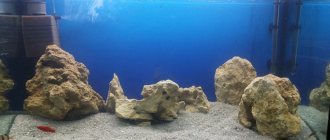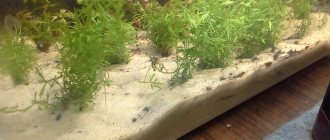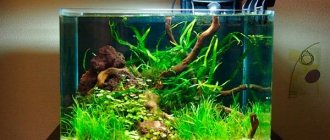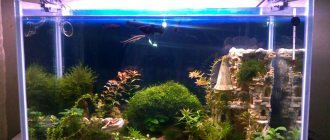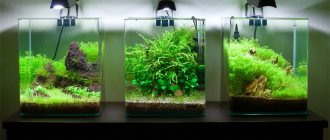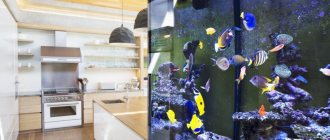Soil is an important component of the aquarium ecosystem. It serves as a natural biofilter in which beneficial microorganisms live, processing organic waste into harmless substances. Plants take root in the bottom substrate and some species of fish, mollusks and arthropods settle. In addition, correctly selected soil serves as a design element and decoration of an artificial reservoir. Aquarists often use quartz sand as a substrate for an aquarium.
Pros and cons of quartz sand
Quartz sand for an aquarium has its advantages and disadvantages. The positive features of this type of substrate include:
- availability;
- natural origin;
- natural appearance;
- uniformity;
- absence of impurities;
- neutrality and chemical inertness;
- resistance to carbon dioxide;
- the possibility of plants rooting in it;
- ensuring good circulation of water between soil particles;
- safety for aquarium inhabitants;
- the ability to accumulate manganese and iron when they are excessively contained in water.
Among the disadvantages of quartz sand are:
- a large number of fine particles that muddy the water and cake at the bottom of an artificial reservoir, leading to acidification of the soil;
- the need for treatment before placing in the aquarium;
- low content of nutrients necessary for plant growth, resulting in the need to use fertilizers.
Variety of palettes
If you think that you will be limited to only one sand coloring option, then this is not the case at all. Indeed, thanks to the imagination of manufacturers, you can use completely different shades at the bottom of your aquarium. Let's take a closer look at them.
- White will perfectly highlight the natural color of plants, and make them visually more contrasting, and therefore more noticeable against a white background.
- Black sand can perfectly complement the entire range of colors of your fish. Bright colors are wonderfully emphasized by the dark filler of the bottom layer of the aquarium. That is why you can successfully use this to create an even greater impression when you see the inhabitants of your home “ocean”.
- If you are a color palette connoisseur and understand which colors go best with what, then there is an incredibly diverse range of the brightest and most colorful sand colors to choose from. You can choose your favorite shade or one that goes well with the color of your fish.
Whatever color you choose, it will not stain the water, so don’t worry about that.
What faction is there?
Quartz soil is represented by the following fractions:
- dusty (particle sizes less than 0.1 mm);
- fine-grained (particle sizes 0.1-0.25 mm);
- medium-grained (particle sizes 0.25-0.5 mm);
- coarse-grained (particle sizes 0.5-3 mm).
The choice of fraction depends on the purpose of the soil. For bottom dwellers, fine and medium-grained sand is suitable: the particle size should be such that fish can burrow freely, but the substrate should not get into the gills. In a densely planted herbal garden, coarse sand should be used to ensure good water circulation and prevent caking and acidification of the soil.
Color spectrum
Natural quartz can have different shades - from white to black. The color scheme is important when selecting quartz sand for an aquarium with a certain design. In addition, using bedding of the desired shade, you can highlight the special characteristics of the aquarium inhabitants. For example, black quartz sand will highlight the bright colors of fish, and white sand will highlight plants.
You can find colored sand in pet stores. It is made of quartz, dyed with artificial dyes in a variety of bright colors. This substrate is not suitable for aquariums that imitate the natural environment, but will look good in richly decorated artificial reservoirs.
What to choose?
Quartz sand is an already processed version of aquarium filler. However, many underwater enthusiasts, in an attempt to get sand filler, simply collect several scoops at the bottom of the river. This can be done, but you should pay attention to the presence of clay and other contaminants in the sand. In color it can be dark, black, and the grains of sand themselves have the shape of a circle.
In most cases, the filler needs to be washed and cleaned before use so that it does not clog the water with turbidity, excess algae and bacteria. If the collected river sand is properly prepared, then it is quite possible to use it.
Purchased quartz filler is a ready-made option. By itself, it is white and completely homogeneous; each grain of sand is more like a square in shape.
Preparation and placement on the bottom of the aquarium
Before placing it in an artificial pond, the substrate should be properly prepared. Preparing sand for an aquarium with your own hands is not very difficult and takes a little time.
The purchased soil must be poured into a separate container and washed with running water to remove dust. The water needs to be drained several times until it is no longer cloudy. Then the substrate is boiled in a saucepan for 15-20 minutes, stirring constantly, or calcined in the oven for 30 minutes at a temperature of 100°C, spreading over a baking sheet in an even thin layer.
The soil prepared in this way is poured onto the bottom of the aquarium, using a spatula to evenly distribute its particles over the surface. The tool is kept close to the bottom so as not to damage the glass.
Sand is poured in an even layer or a slope is formed towards the front wall of the aquarium. In this case, the thickness of the layer at the back wall can reach 8 cm, at the front - 2-3 cm. An aquarium with such a laying of the substrate is more convenient to clean. The bottom area under the feeder is left without litter or covered with a very thin layer. This makes it easier for fish to collect food from the bottom.
When using a substrate of different fractions, it is covered in layers: first a smaller one, and on top of it a larger one. This will improve aeration and help prevent soil acidification.
Decoration
Nowadays, aquascaping is a fashionable trend - decorating an aquarium in the form of a beautiful natural (not necessarily underwater) landscape. If you do not want to chase fashion, but want to show individuality, it is better to listen only to your imagination. You can create an urban picture or a psychedelic landscape in your pond with a bright pink bottom, ultraviolet lighting and phosphorescent fish.
Once you have decided on the style, you need to start thinking about the composition. The accent, the energy center of the display in the aquarium, can be a snag, a hummock, a stone or group of stones, a bush, as well as a castle or grotto. It is recommended to locate this epicenter not in the middle of the aquarium, but slightly to the right or left, observing the proportions of the golden ratio.
You can use stones. To prevent large fish from knocking them over, it is recommended to tie or glue the boulders together. In shrimp tanks, the most popular are large pieces of sandstone with many small caves, and in cichlid tanks, flat stones are often used, which are placed on top of each other, building grottoes and caves. If the aquarium is intended more for beauty, you can decorate it in the Japanese Iwagumi style, creating a garden from an odd number of stones of different sizes standing or lying on the bottom.
You can use purchased or hand-crafted driftwood. It is beautiful in itself, but if you wish, you can additionally decorate the wood with moss, plants, pebbles and shells.
As additional decorations, clay shards, ceramic tubes of different diameters can be used (catfish and loaches like to occupy the large ones, shrimp like the small ones), and halves of a coconut shell. You can grow moss or fern onto the coconut. Nowadays, all kinds of bubble-blowing crocodiles and divers in aquadesign are considered signs of bad taste, but when decorating an aquarium in a nursery, their presence is quite justified.
Sand care
Over time, a large amount of organic waste accumulates in the substrate, which begins to decompose. This releases compounds that poison fish and stimulate algae growth, which leads to cloudy water. To avoid this, the soil should be cleaned periodically.
A siphon is used to clean the bottom. It is a hose with a funnel at the end. During the cleaning process, a vacuum is created in the hose, as a result of which water with excess sludge enters a separate container. To prevent soil particles and aquarium inhabitants from getting into the hose along with the water, a mesh is put on the funnel.
If there are a lot of plants in the aquarium, the substrate is siphoned for the first time a year after the launch of the artificial pond. It is not recommended to carry out cleaning earlier, because... During this period of time, nutrients necessary for plants accumulate in the litter and beneficial microorganisms multiply. In the future, soil cleaning is carried out as necessary every few months.
If there are no plants in the aquarium, cleaning is carried out within a month after starting. Subsequently, the litter is siphoned weekly, removing fish waste products and food residues.
On a note! It is not recommended to completely rinse the soil in a normally functioning aquarium. The litter is washed only when the artificial reservoir is restarted.
Popular brands
You can find sand for aquariums from different manufacturers on sale. The most popular brands are:
- EcoGrunt. White quartz sand. Sold packaged in 3.5 kg bags. The soil is sifted, washed and calibrated in size. Suitable for freshwater and marine ecosystems.
- Barbus "Caribbean". White quartz sand. Packaged in bags of 1 and 3.5 kg. Particle size – 0.4-1 mm. The soil is ready for use and does not require additional processing.
- Dennerle. The manufacturer produces quartz soils for aquariums of different fractions and different colors, including artificially colored ones. It is recommended to wash them before use. The substrate does not contain limestone, so it can be used in aquariums whose inhabitants require soft water.
Other types of sand
In aquariums, you can use other types of sand besides quartz. Among them are:
- Aragonite . This is a natural substrate formed from fragments of corals and mollusk shells, which is obtained by extracting from the seabed. The main property of aragonite is the ability to dissolve in water when the pH drops below 8.2 (pH of natural sea water). When dissolved, calcium and other elements are released from the substrate, alkalizing the environment. Therefore, aragonite sand is used for aquariums with inhabitants requiring hard water, as well as in marine aquariums. Aragonite is lightweight, which means it does not cake or sour, and its porous structure serves as a habitat for beneficial microorganisms.
- Marine . This type of sand usually has very fine particle sizes. As a result, the soil does not allow water to pass through well, cakes, and beneficial microorganisms do not develop in it due to insufficient aeration. As a result, the substrate quickly sours, leading to water spoilage. When using sea sand in a freshwater aquarium, it must be thoroughly rinsed of salt, otherwise it can destroy the entire ecosystem.
- River . This sand can be of different colors and fractions. Unlike quartz, it always contains an admixture of clay and silt. Soil containing a large amount of clay is difficult to wash; it tends to cake and sour in the aquarium. Therefore, it is recommended to collect river sand in places with the least clay content or buy an already washed substrate.
How to choose?
In order to start a new aquarium and ensure its normal functioning, it must have a high-quality substrate. When choosing sand, you should take into account its fraction, origin and layer thickness.
You should not take into account only the decorative component; this is not enough for the quality functioning of the aquarium.
Characteristics of sand that should be taken into account when choosing a substrate for an aquarium.
- Fraction. You should not choose microscopic sand or with too large a fraction. The optimal size is considered to be 1.5-2 millimeters. Provided that there are fewer grains of sand, aeration deteriorates, stagnation and the development of bacteria occur. If the pebbles are too large, then organic matter is poorly washed out of it, and vegetation does not take root well.
- The thickness of the sand layer should ideally be from 4 to 6 millimeters. This indicator promotes the growth and development of living beings and plants in an artificial ecosystem.
- Kind of sand. It is worth remembering that red and yellow sand contains a large amount of iron. Limestone chips can disrupt the rigidity of the water balance, which will be detrimental to aquatic organisms.

